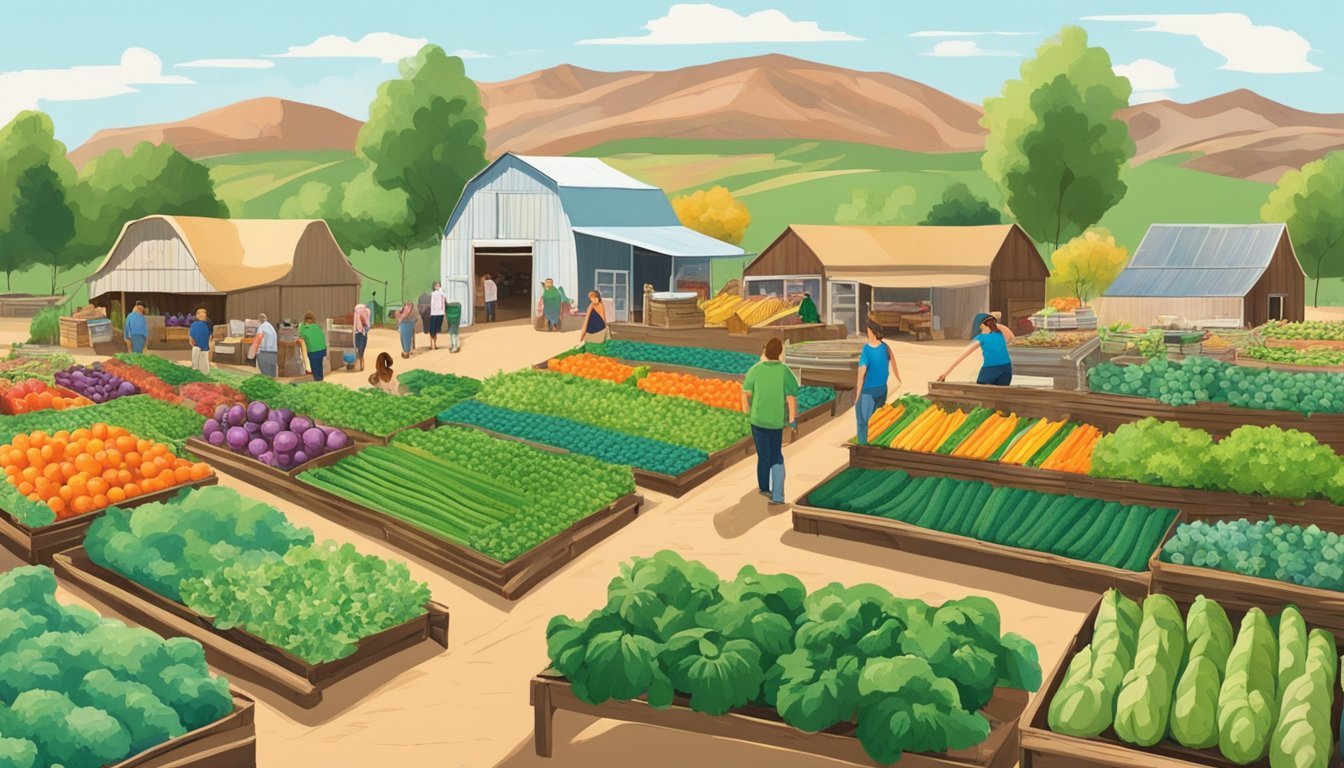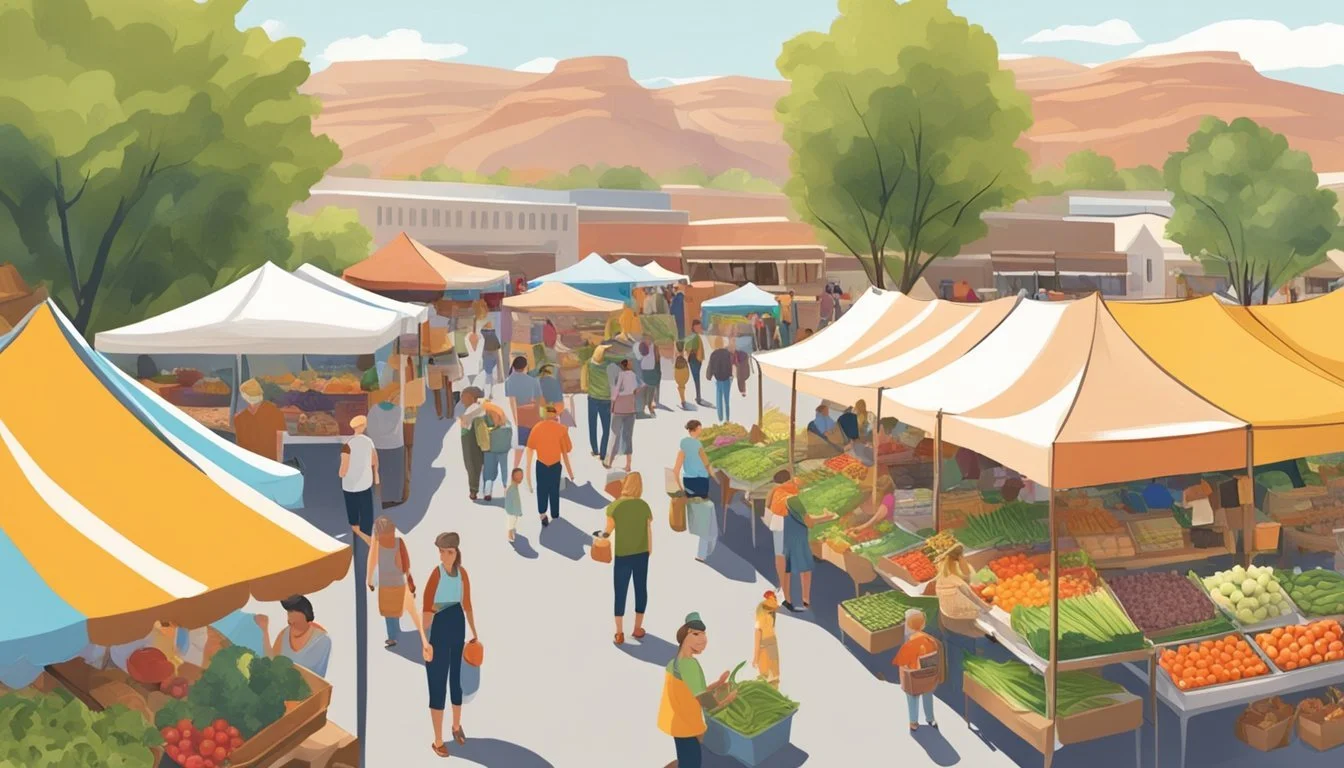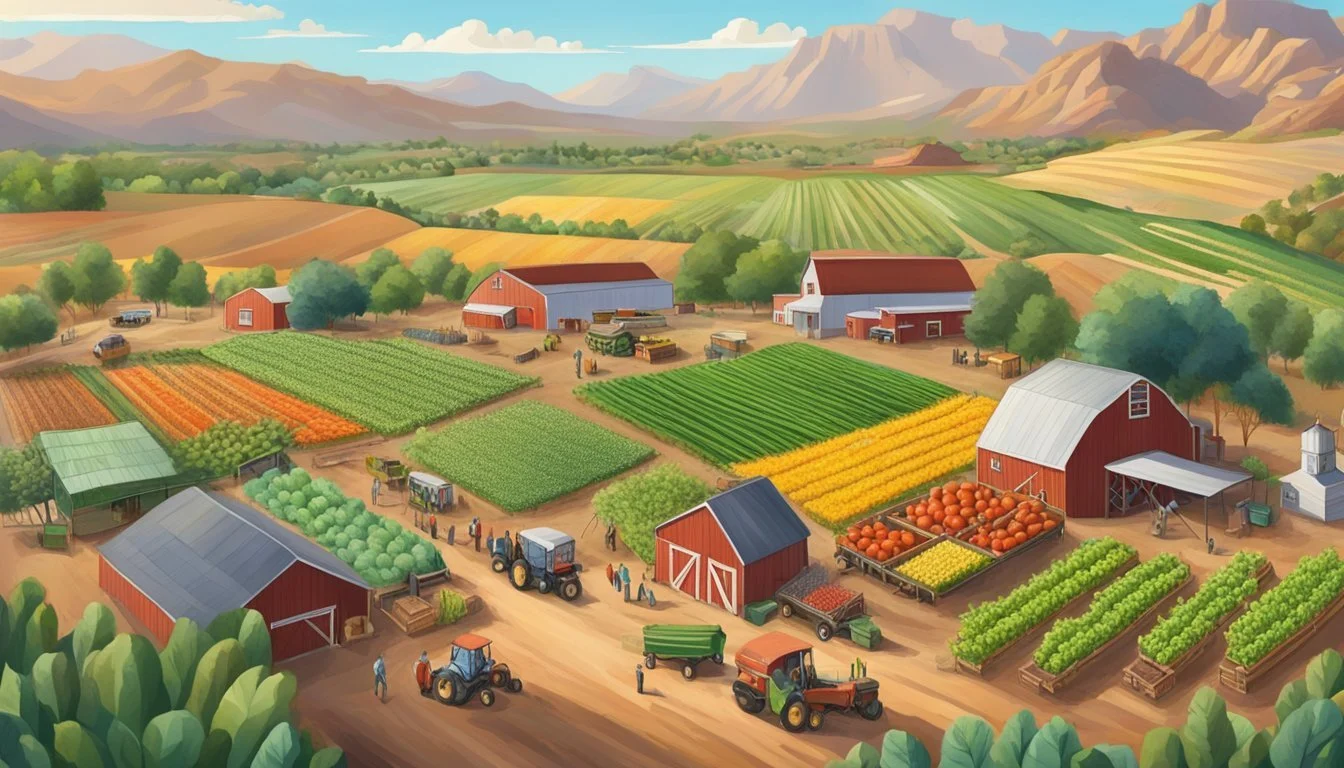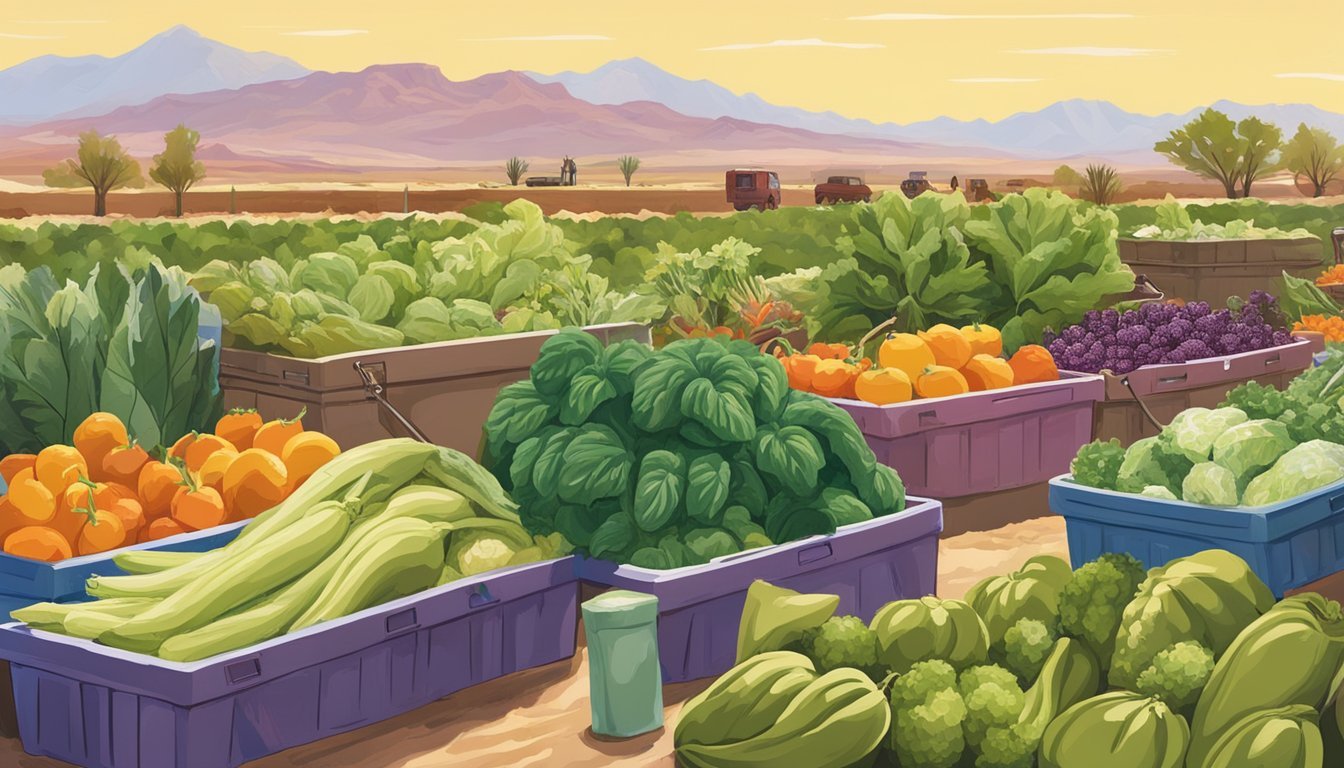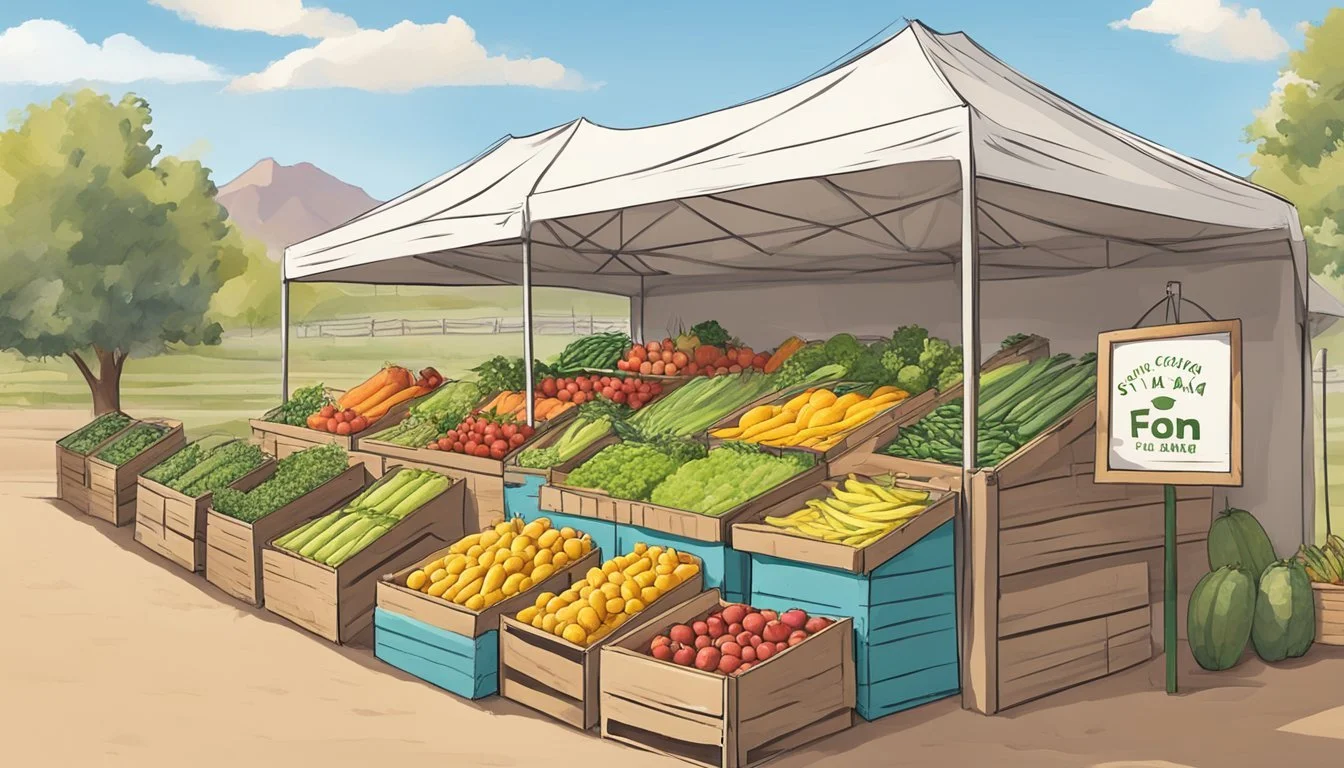Community Supported Agriculture (CSA) in St. George, UT
A Guide to Local Produce and Farms
Community Supported Agriculture (CSA) is an innovative model for food production and distribution that connects farmers and consumers within the local community. This approach allows consumers in St. George, UT to purchase seasonal produce directly from local farms, fostering a relationship between the grower and the consumer that is based on mutual support and the shared risks and benefits of food production.
In St. George, the CSA model not only contributes to the local economy but also encourages sustainable agricultural practices. Members of the CSA pre-purchase a share of the harvest, guaranteeing them a regular supply of fresh, locally-grown produce throughout the farming season. This system reduces food miles, promotes environmental stewardship, and supports St. George farmers to receive a fair price for their efforts.
As St. George has embraced the CSA model, it has seen a myriad of benefits, such as the preservation of farmland and a reduction in food waste. Consumers become intimately connected with the source of their food and learn more about the process of agriculture from sowing to harvest, leading to greater appreciation for the hard work that goes into farming. Community Supported Agriculture represents a growing movement in St. George, where eating fresh and locally is not just a trend but a commitment to the health and well-being of the community.
Overview of CSAs
Community Supported Agriculture (CSA) presents a model where local residents become shareholders in Utah's agricultural produce. By purchasing shares, individuals directly support farmers and local farms, ensuring not only fresh goods but also fortifying community values.
Benefits of Joining a CSA
Joining a CSA in St. George offers distinct advantages. Shareholders receive a weekly or bi-weekly bounty of fresh, seasonal produce, reflecting a breadth of quality that supermarkets often cannot match. They gain the opportunity to introduce unique and local varieties of fruits and vegetables to their diet. In addition, being a CSA member encourages healthier eating habits and supports agricultural practices that protect the environment by conserving natural resources and reducing the reliance on fossil fuels due to short transportation distances.
Health and Freshness: Access to nutrient-rich, freshly harvested produce.
Environmental Impact: Reduced carbon footprint through local consumption.
Community Connection: Direct relationships with the people who grow your food, enriching community ties.
Education: Learning about sustainable agriculture and seasonal eating.
How CSAs Strengthen Local Economy
When a consumer partakes in a CSA program in St. George, they help to foster an economically viable model for small businesses and local farms. These agriculture systems contribute to preserving the unique character of the region while also offering full-time employment to local residents. Dollars spent locally recirculate within the community, bolstering service-oriented businesses and promoting a sustainable economy.
Economic Multiplier: Local spending leads to secondary economic benefits.
Sustainability: Investment in practices that enhance soil health and biodiversity.
Viability of Farms: Shareholders provide a dependable income stream for farms.
Resource Allocation: More efficient usage of water and land, vital in Utah's climate.
By aligning with the ethos of CSA, St. George residents partake in a systemic solution that sustains quality, reinforces local values, and is inherently designed to be environmentally mindful and economically beneficial for the region.
CSA Farm Operations
Community Supported Agriculture in St. George, UT, primarily involves farmers employing sustainable farming practices to provide a diverse range of seasonal produce. These operations focus on organic farming and maintaining harmony with nature.
Seasonal Produce and Farming
Farmers in St. George, UT, cultivate crops according to the growing season, ensuring peak flavor and genetic diversity. Produce availability follows the natural cycles, offering consumers a variety of fresh fruits and vegetables throughout the year. Seasonal farming dictates the offerings as follows:
Spring: Tender leafy vegetables like spinach and lettuce
Summer: Juicy fruits such as tomatoes and berries
Fall: Root vegetables and squash varieties
Winter: Hardy greens and stored harvest
By planting seeds and tending soil tuned to the local climate, these farmers minimize the distance food travels, affording fresher produce to CSA shareholders.
Organic and Natural Farming Practices
Organic and natural methods are at the heart of CSA farm operations, which emphasize soil health and reduce reliance on fossil fuels. Farmers integrate practices that:
Avoid synthetic pesticides and fertilizers: Promoting a pure and safe food supply
Embrace composting and crop rotation: Preserving soil health and reducing disease
Utilize heirloom seeds: Enhancing crop genetic diversity
Encourage natural pollinators: Maintaining ecological balance
These methods foster crops that grow in harmony with the region's environment, resulting in high-quality produce while supporting sustainable farming.
Participating in CSAs
Community Supported Agriculture (CSA) in St. George, Utah, provides an opportunity for consumers to eat fresh, seasonal produce while supporting local agriculture. By becoming shareholders, individuals can pre-purchase a portion of the farm's harvest, which offers mutual benefits in terms of budgeting and reliable access to quality food.
Understanding CSA Shares
A CSA share represents a portion of the farm's produce that a consumer can purchase before the growing season begins. Typically, these shares vary in size and cost, accommodating different household needs and budgets. In St. George, CSA shares often focus on a variety of vegetables, but some CSAs may include additional farm products like eggs or honey.
Share Sizes and Prices in St. George CSAs:
Small Share: Suitable for individuals or small families. Usually includes 5-7 types of vegetables.
Large Share: Best for larger households, often providing 10-12 different vegetables.
Shareholders should carefully consider their household's consumption and budget before deciding on the size of the share they purchase.
The Commitment of Shareholders
When someone becomes a CSA shareholder, they make a financial commitment to a local farm for the season. This commitment involves upfront payment which secures their share of the harvest throughout the growing season. Shareholders also share in the risks of farming, such as unpredictable weather affecting the crop yield.
Responsibilities of CSA Shareholders Include:
Monetary Investment: An upfront sum of money that supports the farm's operation costs.
Shared Risk: Acknowledgment that crop yield can vary due to environmental factors.
Regular Pickups: Commitment to pick up their shares at designated locations and times.
Joining a CSA in St. George allows shareholders to participate directly in the local food system, ensuring they eat fresh while contributing to the sustainability of CSA work and empowering local farmers.
CSA Member Experience
Joining a Community Supported Agriculture program in St. George, UT, offers residents a unique and engaging way to obtain fresh, locally grown produce, while fostering a connection with the farms where their food originates.
Field Events and Community Engagement
CSA farms in St. George often invite their members to participate in field events, aiming to strengthen the community bond. Members can experience hands-on activities ranging from planting to harvesting, allowing a deeper understanding of sustainable agriculture practices. Engagement events not only provide a learning experience but also foster a sense of community among members who share a passion for local food systems.
Know Your Farmer, Know Your Food
By becoming a CSA member, individuals have the opportunity to visit farms and directly converse with farmers, creating transparency about where their food comes from. These farm visits and discussions enable members to learn about the growing process and the challenges involved in sustainable farming. The farms may also communicate through regular newsletters, keeping members informed about the food supply, farm conditions, and available local produce—enhancing the overall experience of eating fresh and knowing the source of one's food.
Product Range of Local CSAs
The CSAs in St. George offer a diverse selection of farm-fresh products. Subscribers can enjoy a rich variety of locally-grown produce as well as meat and dairy options throughout the growing season.
Vegetables and Fruit Offerings
Local CSAs provide a vibrant palette of vegetables and fruit, reflecting the region’s ecosystem and the dedication of local farmers. Subscribers can expect a seasonal rotation that includes, but is not limited to:
Spring: Lettuces, radishes, and heirloom tomatoes
Summer: Bell peppers, cucumbers, and various berries
Fall: Hearty squashes, apples, and root vegetables
Each week brings a new assortment, ensuring freshness and variety. It’s not only a tasting journey through the seasons but also a testament to the sustainable practices of St. George's CSAs.
Beyond Produce: Meat, Dairy, and More
St. George's CSAs go beyond produce to offer a selection of local products including meats and dairy:
Meat: Ranging from pasture-raised chicken to 100% grass-fed beef, available in various cuts.
Dairy: Including fresh milk, artisan cheeses, and yogurt from local dairies.
These products provide a fuller farm-to-table experience, supporting a complete local food ecosystem. Subscribers enjoy the benefits of knowing exactly where their meat and dairy come from and the practices employed by their local farmers.
Sustainability and Environment
Community Supported Agriculture (CSA) initiatives in St. George, Utah, are a testament to the region's dedication to sustainability and environmental stewardship. By prioritizing local produce, CSAs play a critical role in conserving natural resources and reducing reliance on fossil fuels typically associated with shipping requirements.
Reducing Carbon Footprint through CSAs
In St. George, CSAs contribute to a smaller carbon footprint by minimizing the distance food travels from farms to consumers. Supporting local farms means that the shipping requirements for transporting produce over long distances are significantly reduced. This directly diminishes the reliance on fossil fuels used in transportation, making CSA participation a more sustainable choice.
Local Produce: By purchasing locally grown goods, residents effectively lower emissions associated with food transport.
Conserve Natural Resources: Shortened supply chains mean less energy spent, conserving natural resources.
Preservation of Local Ecosystems
CSAs in St. George align with the practices that protect the environment and promote harmony with nature. By fostering the growth of diverse crops and reducing the need for harmful agricultural inputs, CSAs help maintain the health and balance of local ecosystems.
Ecosystem Health: Diversity in crop cultivation leads to healthier soils and habitats, supporting various flora and fauna.
Harmony with Nature: CSA farms often employ organic and regenerative farming practices, working in sync with nature, rather than against it.
Local CSA Examples
Community Supported Agriculture (CSA) in St. George, Utah, showcases a thriving commitment to locally produced goods, uniting the Utah community with the unique character of its local farms. It enables consumers to directly support the efforts of regional growers, reinforcing the bond between the land and the table.
Lau Family Farm
The Lau Family Farm offers a range of local products that emphasize sustainability and community engagement. They provide an assortment of meats, including beef, chicken, and lamb—each ethically raised to ensure the highest quality. By embracing CSA, Lau Family Farm forges a direct connection with its customers, fostering a shared ethic of responsible agriculture within the Utah community.
Red Acre Farm
Red Acre Farm stands out with its eclectic variety of offerings, from fresh vegetables and herbs to hand-picked flowers. As a cornerstone of the local CSA scene, Red Acre goes beyond the traditional farm stand. They host workshops and classes, emphasizing the importance of agro-education and the diverse potential of community supported agriculture. Red Acre Farm, deeply rooted in its locality, invites its members to experience the full cycle of food production.
How to Find and Join a CSA in St. George, UT
To locate and join a Community Supported Agriculture (CSA) program in St. George, UT, interested individuals should begin with a search using local directories or online platforms that list local farms. Websites like LocalHarvest are practical tools that provide detailed listings of CSAs. They can input their city or zip code to find nearby CSA options.
It is beneficial to buy local; therefore, individuals should seek CSAs that collaborate with local farmers. This supports the Utah community's agricultural base and ensures fresh, seasonal produce. A visit to local farmers' markets can also provide leads on CSAs. Additionally, engaging with local food groups on social media may yield recommendations.
Prospective members can use resources provided by educational institutions, such as the University of Massachusetts Extension, which offer guides on selecting and joining CSAs. In Utah, consulting with local extensions of the EPA or agriculture departments can also be highly informative.
When joining a CSA, customers typically purchase a "share" which entitles them to a portion of the farm's production. Before committing, they should understand the terms, pick-up locations, seasonal offerings, and costs involved.
Steps to Joining a CSA:
Search for a CSA near St. George, UT using online resources or local contacts.
Contact chosen CSA to confirm availability of shares and understand the terms.
Purchase a share and arrange pick-up locations and schedule.
By following these steps, consumers can join a CSA and contribute to a sustainable, local food system.
CSAs and the Future of Local Farming
Community Supported Agriculture (CSA) in St. George, UT, stands at a crucial intersection of tradition and innovation, with the potential to redefine the relationship between farmers and the community they feed. The emphasis is on fostering profitable agriculture while maintaining a commitment to environmental and community health.
Challenges and Opportunities for Growth
Challenges:
Competition: Small-scale CSAs are contending with large, centralized farms that benefit from economies of scale.
Climate: Farmers face the uncertainty of climate change, which can affect seasonal produce yields.
Costs: Initial investment and ongoing costs can be significant, making it difficult for farmers to maintain profitability.
Opportunities:
Market Demand: An increasing number of consumers prefer locally sourced food, which could drive CSA membership.
Technology: Advances in farming technology can help CSAs in St. George increase efficiency and crop yields.
Networking: Forming cooperatives can provide farmers with shared resources and knowledge, reducing individual costs.
Farmers must evaluate their practices to navigate these challenges and leverage opportunities for sustainable growth.
Educational Aspects and Public Outreach
Education:
Workshops: Educational workshops can train new farmers in CSA practices and sustainable agriculture techniques.
School Programs: Partnering with schools to educate children on the origins of their food can foster early appreciation for local farming.
Public Outreach:
Community Events: Hosting events at farms or local markets broadens community engagement and awareness of CSAs.
Social Media: Effective use of platforms can highlight the seasonal availability of CSA produce and promote direct interaction with farmers.
Through education and outreach, CSAs can cultivate informed consumers who understand and support the value of local farming in St. George's future.

